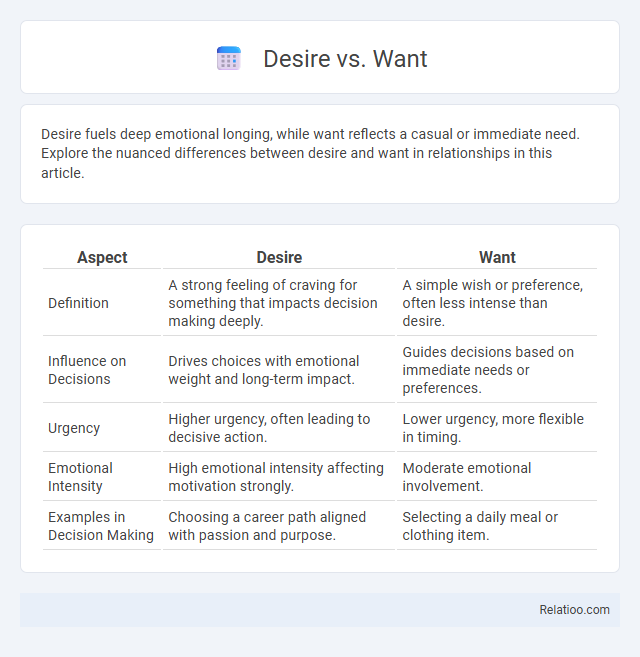Desire fuels deep emotional longing, while want reflects a casual or immediate need. Explore the nuanced differences between desire and want in relationships in this article.
Table of Comparison
| Aspect | Desire | Want |
|---|---|---|
| Definition | A strong feeling of craving for something that impacts decision making deeply. | A simple wish or preference, often less intense than desire. |
| Influence on Decisions | Drives choices with emotional weight and long-term impact. | Guides decisions based on immediate needs or preferences. |
| Urgency | Higher urgency, often leading to decisive action. | Lower urgency, more flexible in timing. |
| Emotional Intensity | High emotional intensity affecting motivation strongly. | Moderate emotional involvement. |
| Examples in Decision Making | Choosing a career path aligned with passion and purpose. | Selecting a daily meal or clothing item. |
Understanding the Difference Between Desire and Want
Desire represents a deeper emotional drive that motivates long-term goals, while want refers to a more immediate or superficial craving for something. Understanding the difference between desire and want is essential for prioritizing actions that align with core values and personal fulfillment. Desire often fuels meaningful change, whereas wants may satisfy short-term impulses without lasting impact.
The Psychology Behind Desire and Want
Desire and want are distinct psychological constructs where desire represents a deeper emotional drive often linked to long-term fulfillment, while want reflects immediate, surface-level cravings driven by external stimuli. Your brain processes desire through complex motivational systems involving dopamine and reward pathways, which sustain persistent pursuit and attachment, whereas wants frequently trigger transient satisfaction without deeper emotional investment. Understanding these differences helps you recognize how underlying psychological mechanisms influence decision-making and behavior in goal-setting and consumption patterns.
Origins: Where Do Our Desires and Wants Come From?
Desires and wants originate from complex interactions between biological drives, individual experiences, and social influences. Neurologically, the limbic system triggers emotions linked to desires, while cultural conditioning shapes the specific objects or goals we crave. Evolutionary psychology explains that these impulses evolved to ensure survival and reproduction, making desires deeply rooted yet adaptable to personal and societal contexts.
Desire vs Want: Impact on Decision Making
Desire drives long-term motivation by aligning with core values and emotional satisfaction, influencing decisions that prioritize meaningful goals over immediate gratification. Want typically relates to short-term preferences or impulses, often leading to choices based on convenience or momentary needs. Understanding the distinction between desire and want enhances decision making by encouraging focus on sustained fulfillment rather than transient satisfaction.
Emotional Drivers of Desire and Want
Desire stems from deep emotional drivers such as passion, longing, and personal fulfillment, often linked to intrinsic motivations and identity. Want is driven more by immediate needs or external influences, reflecting a pragmatic or superficial level of attachment. Understanding these emotional distinctions helps marketers tailor messaging that resonates with either enduring emotional aspirations or short-term consumer impulses.
How Desire and Want Influence Behavior
Desire drives deep emotional motivation, often leading to long-term goals and fulfilling innermost aspirations, while want reflects immediate needs or preferences that influence short-term actions. Desire triggers persistent pursuit and greater effort, shaping consistent behavior patterns that align with personal values. Want shapes daily decisions by prioritizing specific choices that satisfy current situational demands or comfort.
Fulfilling Desires vs Satisfying Wants
Fulfilling desires often involves deep emotional or psychological fulfillment tied to long-term goals or values, whereas satisfying wants addresses immediate or surface-level needs often driven by external influences. Your ability to distinguish between desires and wants can lead to more meaningful choices, focusing on what truly enriches your life rather than momentary gratification. Understanding this difference enhances decision-making and well-being by prioritizing what contributes to lasting satisfaction over temporary pleasure.
The Role of Desire and Want in Goal Setting
Desire fuels your motivation by igniting a deep emotional connection to your goals, making them feel essential and meaningful. Want represents a more surface-level wish, often lacking the intensity needed for sustained effort, whereas desire drives persistence and resilience through challenges. Understanding the difference between desire and want helps you set clearer, more compelling goals that inspire action and long-term commitment.
Managing Desires and Wants for Personal Growth
Managing desires and wants is essential for personal growth, as unchecked cravings can lead to impulsive decisions and hinder long-term goals. Cultivating self-awareness helps distinguish between fleeting wants and meaningful desires, enabling more deliberate and value-driven choices. Practicing mindfulness and self-discipline reinforces the control over urges, fostering resilience and sustained progress toward personal development.
Desire and Want in Consumer Culture
Desire in consumer culture represents a deep, emotional yearning that drives individuals to seek products or experiences symbolizing status, identity, or fulfillment beyond basic needs. Want, by contrast, refers to specific products or services shaped by cultural influences and marketing efforts that align with your personal preferences and lifestyle. Understanding the distinction between desire's emotional pull and want's tangible expression helps businesses craft targeted strategies that resonate with consumer motivations.

Infographic: Desire vs Want
 relatioo.com
relatioo.com